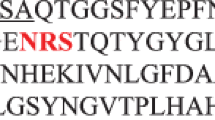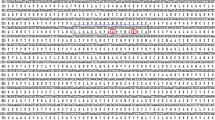Abstract
A novel endo-1,3(4)-β-d-glucanase gene (bgl16C1) from Penicillium pinophilum C1 was cloned and sequenced. The 945-bp full-length gene encoded a 315-residue polypeptide consisting of a putative signal peptide of 18 residues and a catalytic domain belonging to glycosyl hydrolase family 16. The deduced amino acid sequence showed the highest identity (82%) with the putative endo-1,3(4)-β-glucanase from Talaromyces stipitatus ATCC 10500 and 60% identity with the characterized β-1,3(4)-glucanase from Paecilomyces sp. FLH30. The gene was successfully overexpressed in Pichia pastoris. Recombinant Bgl16C1 constituted 95% of total secreted proteins (2.61 g l−1) with activity of 28,721 U ml−1 in a 15-l fermentor. The purified recombinant Bgl16C1 had higher specific activity toward barley β-glucan (12,622 U mg−1) than all known glucanases and also showed activity against lichenan and laminarin. The enzyme was optimally active at pH 5.0 and 55°C and exhibited good stability over a broad acid and alkaline pH range (>85% activity at pH 3.0–7.0 and even 30% at pH 11.0). All these favorable enzymatic properties make it attractive for potential applications in various industries.



Similar content being viewed by others
Abbreviations
- CMC-Na:
-
Carboxymethyl cellulose-sodium salt
- TAIL–PCR:
-
Thermal asymmetric interlaced polymerase chain reaction
- SDS-PAGE:
-
Sodium dodecyl sulfate-polyacrylamide gel electrophoresis
- DNS:
-
3,5-Dinitrosalicylic acid
- RT–PCR:
-
Reverse-transcription polymerase chain reaction
- ORF:
-
Open reading frame
- MALDI-TOF:
-
Matrix-assisted laser desorption/ionization time-of-flight
References
Boyce A, Walsh G (2007) Production, purification and application-relevant characterisation of an endo-1,3(4)-β-glucanase from Rhizomucor miehei. Appl Microbiol Biotechnol 76:835–841
Bai Y, Wang J, Zhang Z, Shi P, Luo H, Huang H, Luo C, Yao B (2010) A novel family 9 β-1,3(4)-glucanase from thermoacidophilic Alicyclobacillus sp. A4 with potential applications in the brewing industry. Appl Microbiol Biotechnol 87:251–259
Bradford MM (1976) A rapid and sensitive method for the quantitation of microgram quantities of protein utilizing the principle of protein-dye binding. Anal Biochem 72:248–254
Buliga GS, Brant DA, Fincher GB (1986) The sequence statistics and solution conformation of a barley (1 → 3,1 → 4)-β-d-glucan. Carbohydr Res 157:139–156
Cai H, Shi P, Bai Y, Huang H, Yuan T, Yang P, Luo H, Meng K, Yao B (2011) A novel thermoacidophilic family 10 xylanase from Penicillium pinophilum C1. Process Biochem 46:2341–2346
Cai H, Shi P, Luo H, Bai Y, Huang H, Yang P, Yao B (2011) Acidic β-mannanase from Penicillium pinophilum C1: cloning, characterization and assessment of its potential for animal feed application. J Biosci Bioeng. doi:10.1016/j.jbiosc.2011.08.018
Celestino KR, Cunha RB, Felix CR (2006) Characterization of a β-glucanase produced by Rhizopus microsporus var. microsporus, and its potential for application in the brewing industry. BMC Biochem 7:23
Cereghino JL, Cregg JM (2000) Heterologous protein expression in the methylotrophic yeast Pichia pastoris. FEMS Microbiol Rev 24:45–66
Chen H, Li XL, Ljungdahl LG (1997) Sequencing of a 1,3–1,4-β-d-glucanase (lichenase) from the anaerobic fungus Orpinomyces strain PC-2: properties of the enzyme expressed in Escherichia coli and evidence that the gene has a bacterial origin. J Bacteriol 179:6028–6034
Cheng YM, Hong TY, Liu CC, Meng M (2009) Cloning and functional characterization of a complex endo-β-1,3-glucanase from Paenibacillus sp. Appl Microbiol Biotechnol 81:1051–1061
Daly R, Hearn MT (2005) Expression of heterologous proteins in Pichia pastoris: a useful experimental tool in protein engineering and production. J Mol Recognit 18:119–138
Dashtban M, Schraft H, Qin W (2009) Fungal bioconversion of lignocellulosic residues; opportunities and perspectives. Int J Biol Sci 5:578–595
Furtado GP, Ribeiro LF, Santos CR, Tonoli CC, de Souza AR, Oliveira RR, Murakami MT, Ward RJ (2011) Biochemical and structural characterization of a β-1,3–1,4-glucanase from Bacillus subtilis 168. Process Biochem 46:1202–1206
Grishutin SG, Gusakov AV, Dzedzyulya EI, Sinitsyn AP (2006) A lichenase-like family 12 endo-(1 → 4)-β-glucanase from Aspergillus japonicus: study of the substrate specificity and mode of action on β-glucans in comparison with other glycoside hydrolases. Carbohydr Res 341:218–229
Hua C, Yan Q, Jiang Z, Li Y, Katrolia P (2010) High-level expression of a specific β-1,3–1,4-glucanase from the thermophilic fungus Paecilomyces thermophila in Pichia pastoris. Appl Microbiol Biotechnol 88:509–518
Hua C, Yi H, Jiao L (2011) Cloning and expression of the endo-1,3(4)-β-glucanase gene from Paecilomyces sp. FLH30 and characterization of the recombinant enzyme. Biosci Biotechnol Biochem 75:1807–1812
Huang H, Yang P, Luo H, Tang H, Shao N, Yuan T, Wang Y, Bai Y, Yao B (2008) High-level expression of a truncated 1,3–1,4-β-d-glucanase from Fibrobacter succinogenes in Pichia pastoris by optimization of codons and fermentation. Appl Microbiol Biotechnol 78:95–103
Huang XM, Yang Q, Liu ZH, Fan JX, Chen XL, Song JZ, Wang Y (2010) Cloning and heterologous expression of a novel endoglucanase gene egVIII from Trichoderma viride in Saccharomyces cerevisiae. Appl Biochem Biotechnol 162:103–115
Jeya M, Joo AR, Lee KM, Sim WI, Oh DK, Kim YS, Kim IW, Lee JK (2010) Characterization of endo-β-1,4-glucanase from a novel strain of Penicillium pinophilum KMJ601. Appl Microbiol Biotechnol 85:1005–1014
Karboune S, ĽHocine L, Anthoni J, Geraert PA, Kermasha S (2009) Properties of selected hemicellulases of a multi-enzymatic system from Penicillium funiculosum. Biosci Biotechnol Biochem 73:1286–1292
Laemmli UK (1970) Cleavage of structural proteins during the assembly of the head of bacteriophage T4. Nature 227:680–685
Lee KM, Jeya M, Joo AR, Singh R, Kim IW, Lee JK (2010) Purification and characterization of a thermostable endo-β-1,4-glucanase from a novel strain of Penicillium purpurogenum. Enzyme Microb Technol 46:206–211
Li J, Tang C, Shi H, Wu M (2011) Cloning and optimized expression of a neutral endoglucanase gene (ncel5A) from Volvariella volvacea WX32 in Pichia pastoris. J Biosci Bioeng 111:537–540
Lineweaver H, Burk D (1934) The determination of enzyme dissociation constants. J Am Chem Soc 56:658–666
Luo H, Yang J, Yang P, Li J, Huang H, Shi P, Bai Y, Wang Y, Fan Y, Yao B (2010) Gene cloning and expression of a new acidic family 7 endo-β-1,3–1,4-glucanase from the acidophilic fungus Bispora sp. MEY-1. Appl Microbiol Biotechnol 85:1015–1023
Macauley-Patrick S, Fazenda ML, McNeil B, Harvey LM (2005) Heterologous protein production using the Pichia pastoris expression system. Yeast 22:249–270
Miller GL (1959) Use of dinitrosalicylic acid reagent for determination of reducing sugar. Anal Chem 31:426–428
Ooi T, Sato H, Matsumoto K, Taguchi S (2009) A unique post-translational processing of an exo-β-1,3-glucanase of Penicillium sp. KH10 expressed in Aspergillus oryzae. Protein Expr Purif 67:126–131
Planas A (2000) Bacterial 1,3–1,4-β-glucanases: structure, function and protein engineering. Biochim Biophys Acta 1543:361–382
Qiao J, Dong B, Li Y, Zhang B, Cao Y (2009) Cloning of a β-1,3–1,4-glucanase gene from Bacillus subtilis MA139 and its functional expression in Escherichia coli. Appl Biochem Biotechnol 152:334–342
Quay DHX, Bakar FDA, Rabu A, Said M, Illias RM, Mahadi NM, Hassan O, Murad AMA (2011) Over expression, purification and characterization of the Aspergillus niger endoglucanase, EglA, in Pichia pastoris. Afr J Biotechnol 10:2101–2111
Rubini MR, Dillon AJ, Kyaw CM, Faria FP, Pocas-Fonseca MJ, Silva-Pereira I (2010) Cloning, characterization and heterologous expression of the first Penicillium echinulatum cellulase gene. J Appl Microbiol 108:1187–1198
Shi P, Yao G, Yang P, Li N, Luo H, Bai Y, Wang Y, Yao B (2010) Cloning, characterization, and antifungal activity of an endo-1,3-β-d-glucanase from Streptomyces sp. S27. Appl Microbiol Biotechnol 85:1483–1490
Sun J, Wang H, Lv W, Ma C, Lou Z, Dai Y (2011) Construction and characterization of a fusion β-1,3–1,4-glucanase to improve hydrolytic activity and thermostability. Biotechnol Lett 33:2193–2199
Shumiao Z, Huang J, Zhang C, Deng L, Hu N, Liang Y (2010) High-level expression of an Aspergillus niger endo-β-1,4-glucanase in Pichia pastoris through gene codon optimization and synthesis. J Microbiol Biotechnol 20:467–473
Teather RM, Erfle JD (1990) DNA sequence of a Fibrobacter succinogenes mixed-linkage β-glucanase (1,3–1,4-β-d-glucan 4-glucanohydrolase) gene. J Bacteriol 172:3837–3841
Teng D, Fan Y, Yang YL, Tian ZG, Luo J, Wang JH (2007) Codon optimization of Bacillus licheniformis β-1,3–1,4-glucanase gene and its expression in Pichia pastoris. Appl Microbiol Biotechnol 74:1074–1083
Walsh GA, Murphy RA, Killeen GF, Headon DR, Power RF (1995) Technical note: detection and quantification of supplemental fungal β-glucanase activity in animal feed. J Anim Sci 73:1074–1076
Yang P, Shi P, Wang Y, Bai Y, Meng K, Luo H, Yuan T, Yao B (2007) Cloning and overexpression of a Paenibacillus β-glucanase in Pichia pastoris: purification and characterization of the recombinant enzyme. J Microbiol Biotechnol 17:58–66
Acknowledgments
This research was supported by the National Science and Technology Support Program (2011BADB02), the China Modern Agriculture Research System (CARS-42), and the Key Program of Transgenic Plant Breeding (2009ZX08003-020B).
Author information
Authors and Affiliations
Corresponding author
Rights and permissions
About this article
Cite this article
Chen, X., Meng, K., Shi, P. et al. High-level expression of a novel Penicillium endo-1,3(4)-β-d-glucanase with high specific activity in Pichia pastoris . J Ind Microbiol Biotechnol 39, 869–876 (2012). https://doi.org/10.1007/s10295-012-1087-z
Received:
Accepted:
Published:
Issue Date:
DOI: https://doi.org/10.1007/s10295-012-1087-z




